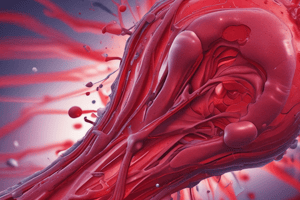Podcast
Questions and Answers
What is the main function of blood?
What is the main function of blood?
- Transporting gases, nutrients, waste products, and hormones (correct)
- Regulating body temperature
- Generating energy for the body
- Producing antibodies
What is the composition of blood?
What is the composition of blood?
- Living cells suspended in water
- Nonliving cells suspended in living matrix called plasma
- Nonliving cells suspended in nonliving matrix called plasma
- Living cells suspended in nonliving matrix called plasma (correct)
What is the approximate percentage of body weight that blood accounts for?
What is the approximate percentage of body weight that blood accounts for?
- 15%
- 3%
- 8% (correct)
- 20%
What is the role of clotting proteins in blood?
What is the role of clotting proteins in blood?
How is carbon dioxide transported in the body?
How is carbon dioxide transported in the body?
Flashcards are hidden until you start studying
Study Notes
Main Function of Blood
- Transports oxygen from the lungs to body tissues and carbon dioxide from tissues to the lungs.
- Delivers nutrients and hormones throughout the body.
- Maintains homeostasis by regulating body temperature, pH, and electrolyte balance.
- Provides immune defense against pathogens through white blood cells.
Composition of Blood
- Composed of plasma (about 55%) and formed elements (about 45%).
- Plasma includes water, electrolytes, proteins, hormones, and waste products.
- Formed elements consist of red blood cells (erythrocytes), white blood cells (leukocytes), and platelets (thrombocytes).
Percentage of Body Weight
- Blood accounts for approximately 7-8% of total body weight.
- An average adult has about 4.5 to 6 liters of blood, depending on size and gender.
Role of Clotting Proteins
- Clotting proteins, or coagulation factors, prevent excessive bleeding by forming blood clots.
- Upon injury, platelets adhere to the site and release substances that activate clotting proteins.
- Fibrin is formed, which creates a mesh that solidifies the clot and seals the wound.
Transport of Carbon Dioxide
- Carbon dioxide is primarily transported in three forms: dissolved in plasma, chemically bound to hemoglobin, and as bicarbonate ions.
- About 7-10% is dissolved directly in blood plasma.
- Approximately 20-23% binds to hemoglobin, forming carbaminohemoglobin.
- Around 70% is converted to bicarbonate (HCO3-) in red blood cells and transported in plasma, aiding in pH balance.
Studying That Suits You
Use AI to generate personalized quizzes and flashcards to suit your learning preferences.




